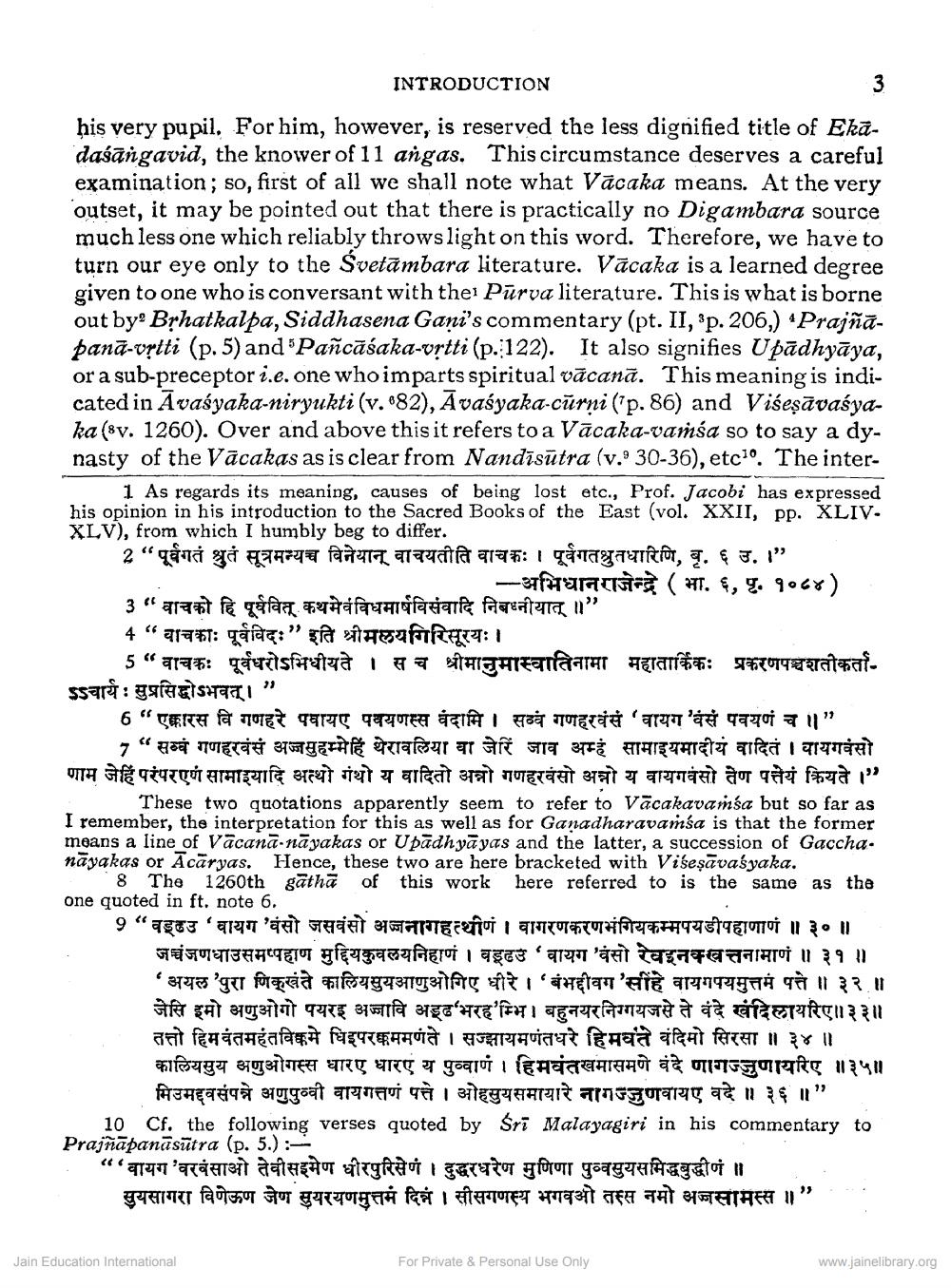________________
INTRODUCTION
his very pupil. For him, however, is reserved the less dignified title of Ekādasaigavid, the knower of 11 angas. Thiscircumstance deserves a careful examination; so, first of all we shall note what Vacaka means. At the very outset, it may be pointed out that there is practically no Digambara source much less one which reliably throws light on this word. Therefore, we have to turn our eye only to the Svetāmbara literature. Vācaka is a learned degree given to one who is conversant with the Pūrva literature. This is what is borne out by Brhatkalpa, Siddhasena Gani's commentary (pt. II, p. 206,) APrajnapanā-vrtti (p.5) and 'Pañcāśaka-vrtti (p. 122). It also signifies Upadhyāya, or a sub-preceptor i.e. one whoimparts spiritual vacanā. This meaning is indi
vasyaka-niryukti (v.82), Avasyaka-cirmi (p.86) and Visesavasyaka (sv. 1260). Over and above this it refers to a Vācaka-vamsa so to say a dynasty of the Vācakas as is clear from Nandīsūtra (v.: 30-36), etc. The inter
1 As regards its meaning, causes of being lost etc., Prof. Jacobi has expressed his opinion in his introduction to the Sacred Books of the East (vol. XXII, pp. XLIV. XLV), from which I humbly beg to differ. 2 "पूर्वगतं श्रुतं सूत्रमन्यच्च विनेयान् वाचयतीति वाचकः । पूर्वगतश्रुतधारिणि, बृ. ६ उ.।"
-अभिधानराजेन्द्रे ( भा. ६, पृ. १०८४) 3" वाचको हि पूर्ववित् कथमेवंविधमार्षविसंवादि निबध्नीयात् ॥" 4 " वाचकाः पूर्वविदः" इति श्रीमलयगिरिसूरयः।
5 " वाचकः पूर्वधरोऽभिधीयते । स च श्रीमानुमास्वातिनामा महातार्किकः प्रकरणपञ्चशतीकर्ताऽऽचार्य: सुप्रसिद्धोऽभवत्।"
6" एकारस वि गणहरे पवायए पवयणस्स वंदामि । सव्वं गणहरवंसं वायग'वंसं पवयणं च ॥"
7" सव्वं गणहरवंसं अज्जसुहम्मे हिं थेरावलिया वा जेरिं जाव अम्हें सामाइयमादीयं वादितं । वायगवंसो णाम जेहिं परंपरएणं सामाइयादि अत्थो गंथो य वादितो अन्नो गणहरवंसो अन्नो य वायगवंसो तेण पत्तेयं क्रियते ।"
These two quotations apparently seem to refer to Vācakavamsa but so far as I remember, the interpretation for this as well as for Ganadharavamsa is that the former means a line of Vacanā nāyakas or Upādhyāyas and the latter, a succession of Gaccha. nāyakas or Ācāryas. Hence, these two are here bracketed with Viseşāvasyaka.
8 The 1260th gatha of this work here referred to is the same as the one quoted in ft. note 6. 9 "वइढउ 'वायग'वंसो जसवंसो अज्जनागहत्थीणं । वागरणकरणभंगियकम्मपयडीपहाणाणं ॥३०॥
जच्चंजणधाउसमप्पहाण मुद्दियकुवलयनिहाणं । वडूढउ 'वायग 'वंसो रेवइनक्खत्तनामाणं ॥३१॥ 'अयल 'पुरा णिक्खंते कालियसुयआणुओगिए धीरे । 'बंभद्दीवग'सीहे वायगपयमुत्तमं पत्ते ॥ ३२ ॥ जेसि इमो अणुओगो पयरइ अज्जावि अड्ढ'भरह'म्भि। बहुनयरनिग्गयजसे ते वंदे खंदिलायरिए॥३३॥ तत्तो हिमवंतमहंतविक्कमे घिइपरक्कममणते । सज्झायमणंतधरे हिमवंते वंदिमो सिरसा ॥ ३४ ॥ कालियसुय अणुओगस्स धारए धारए य पुव्वाणं । हिमवंतखमासमणे वंदे णागज्जुणायरिए ॥३५॥
मिउमद्दवसंपन्ने अणुपुत्वी वायगत्तणं पत्ते । ओहसुयसमायारे नागज्जुणवायए वदे ॥ ३६ ॥" 10 Cf. the following verses quoted by Śrī Malayagiri in his commentary to Prajnapanashtra (p. 5.):
""वायग'वरवंसाओ तेवीसइमेण धीरपुरिसेणं । दुद्धरधरेण मुणिणा पुव्वसुयसमिद्धबुद्धीणं ॥ सुयसागरा विणेऊण जेण सुयरयणमुत्तमं दिनं । सीसगणस्य भगवओ तस्स नमो अजसामस्स ॥"
Jain Education International
For Private & Personal Use Only
www.jainelibrary.org




